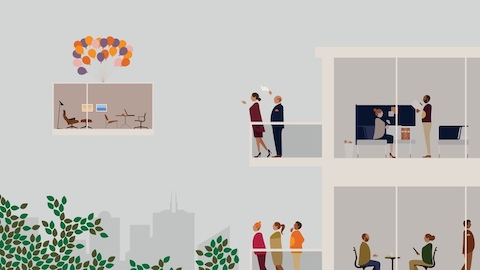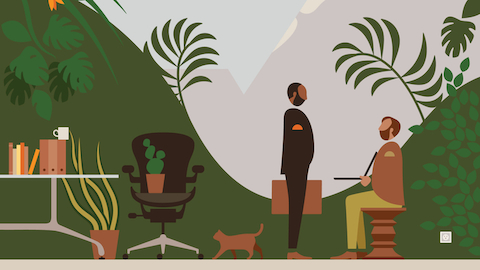If you were to describe what Mars Drinks, a company based in West Chester, PA, does, you might say it supplies single-serving coffee, tea, and hot chocolate delivery systems to other workplaces. But the people who work there say the company’s purpose goes well beyond that.
“Our purpose is to create great tasting moments at work,” says Tracey Wood, Global VP, People and Organization for Mars Drinks. “If you and I were to meet for a talk and we decided to have a coffee, it signals something more than just drinking a cup of coffee. It signals that we are going to have a conversation. We are going to connect.”
More than just a nice-sounding sentiment, a sense of purpose has an impact on the bottom line. People who find meaning in their work are more satisfied, productive, engaged, and connected to the customer, and less likely to leave the company.1 Research sponsored by the Federal Reserve Bank of the U.S. and carried out by economists found that intrinsic motivators, i.e., a sense of purpose and meaning, actually lead to better business results for knowledge work than incentives like bonuses.
Which is why Mars Drinks works hard to ensure that all its employees share its purpose. “Our associates know that they ultimately impact someone else’s work experience. That’s why we are here,” Wood explains.
It’s easy to espouse a purpose; companies do it all the time. But when a company’s purpose is only communicated and not experienced, no one is fooled for long and customers and employees drift away.
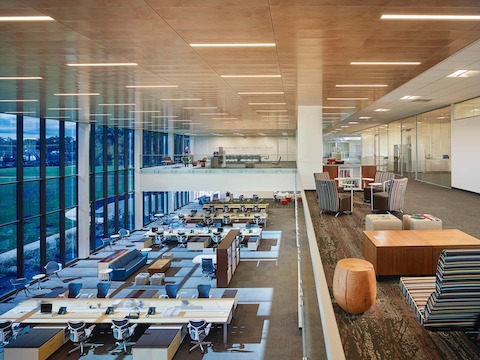
Low visual barriers provide the opportunity to connect and work easily with other team members as well as leadership, leading to a stronger sense of alignment with the company’s mission. (Photos by Halkin | Mason Photography)
Companies can help people experience purpose in a variety of ways, including volunteering and education. In 2015, Ben & Jerry’s franchise owners volunteered at New Orleans Area Habitat for Humanity as part of their planning meeting as one way of fulfilling their purpose to “use [the] company in innovative ways to make the world a better place.” And Patagonia, which uses the business to address the environmental crisis, launched a coast-to-coast Worn Wear Mobile Tour, repairing broken zippers and mending rips and giving fix-it-yourself tutorials. The purpose was to encourage customers to reduce consumption by making their clothing last.
Companies can also convey purpose within their own four walls, typically by putting a mission statement on the wall, displaying items that connect employees directly to customers, or displaying work in process so people see how what they do contributes to the end result.
Perhaps the most overlooked way of communicating purpose, however, is through the layout and design of the office. “Space is a powerful way to help fulfill a sense of purpose,” says Tracy Brower, Herman Miller’s director of Human Dynamics + Work. “When space offers the opportunity to connect with and work easily with other team members, alignment and purpose are more likely to thrive,” because it provides additional opportunities to see how their work fits.
When space doesn’t support purpose, business results can suffer. “If there are too many visual barriers in the space, or if there is a lack of space to connect formally and informally, it can interfere with alignment and purpose, and you won’t see the same results in performance, productivity, shareholder value, or customer satisfaction,” Brower says.
Herman Miller’s Living Office approach to office design starts by addressing basic human needs (purpose, belonging, achievement, autonomy, status, and security), and by understanding the purpose of each space. Because it is based around people and purpose, Living Office is uniquely suited to helping people connect to what matters every day.
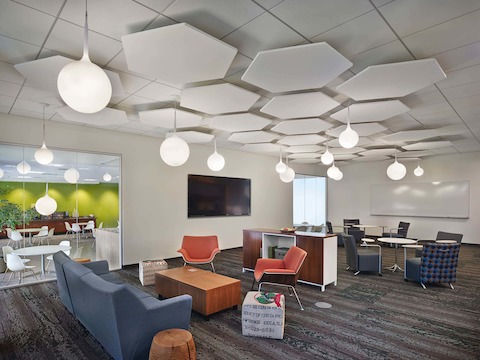
Tables made of wood from the same region as the farms Mars Drinks sources its teas from to remind associates that farmers are an important part of the company’s purpose. (Photos by Halkin | Mason Photography)
GREAT TASTING MOMENTS AROUND EVERY CORNER
In spite of best intentions, office design projects are often driven by square foot per person, budget constraints, and status considerations. Starting with fundamental human needs, however, opens up the possibilities for bringing purpose to life in many ways throughout the space. What a Living Office looks like depends on the company’s purpose and culture.
For Mars Drinks’ Living Office, the most obvious starting point was to create for associates the same experience the company creates for customers. Drink stations are placed strategically throughout the space (not just in a coffee kitchen), so associates see their purpose—“we create great tasting moments at work”—in action every day, all around them. They see how the connections formed over a cup of coffee really are good for business (a fact that’s backed up by MIT research, which found that “teams that go on coffee breaks together are more productive and have stronger social bonds,” according to Fast Company. 2 They see how, when a company provides amenities like drink stations, it makes employees feel valued.
Having benefitted from the experience themselves, employees want to create it for others. It makes them into true believers, thereby aligning individual purpose with organizational purpose. “We want our associates to be excited to come to work every day knowing that they ultimately impact someone else’s work experience,” says Wood.
In addition, throughout the headquarters, photos of the farms that supply the tea (Mars Drinks buys only from sustainable farms) and tables made of wood from the same region as the farms serve as reminders that the farmers, too, are important to their mission. And a unique learning room that overlooks a space where products are being made in real time conveys the idea that achieving purpose requires constant learning from customers, suppliers, and each other.
“When space offers the opportunity to connect with and work easily with other team members, alignment and purpose are more likely to thrive.”
—Tracy Brower, Herman Miller’s director of Human Dynamics + Work
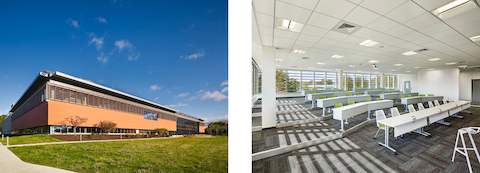
Mars Drinks’ new Living Office in West Chester, PA, supports the company’s purpose and makes work more naturally human, in part by providing access to daylight in public spaces. (Photos by Halkin | Mason Photography)
CULTURE THAT’S “CAUGHT, NOT TAUGHT”
Differentiators are hard to come by these days, and culture is one of the few remaining. While competitors may be able to copy products or poach employees, corporate culture is not easily replicated, and that makes it a competitive advantage.3 “An effective culture…shapes how employees think and act; it outlasts an individual leader; it increases productivity and performance,” 4 says Dave Ulrich, a partner at RBL Group and a professor at University of Michigan’s Ross School of Business. With its emphasis on purpose, Living Office strengthens and reflects a company’s culture.
Living Office is the three-dimensional expression of Mars Drinks’ culture, which rests on its five principles (quality, responsibility, mutuality, efficiency, and freedom). Walls are used sparingly and most of them are transparent, allowing people a clear line of sight to each other and to the outdoors through much of the space. Comfortable lounge seating lends itself to connecting and collaborating; when people need to focus, they can move to smaller, private areas.
This transparency and open layout with lots of choices make it easy for people to collaborate, share best practices, and tell the stories that are a big part of the company’s corporate culture. The environment drives collaboration, participation, the sharing of knowledge, and productivity, ensuring that culture is “caught, not just taught.”
“We want our associates to look, watch, and talk,” says Mars Drinks President Xavier Unkovic—to walk over and talk to a colleague instead of sending an email, for example. That’s good for camaraderie and increases associates’ sense that everyone is in it together. Social science calls this the “mere exposure effect.” Basically, the more we see people, the more inclined we are to like them, even if we don’t interact with them.
But exposure to others does more than make people like each other. According to a study conducted by Herman Miller, people working in spaces that made it easy to regularly see and be around leaders felt more aligned with the organization’s mission.5 In that kind of environment, leaders are able to help employees see how their day-to-day objectives are connected with those of the organization.
“People get a sense of purpose when leaders are visible and accessible and when the leaders reinforce the importance of the individuals’ work and connection to that of the team and the organization,” says Brower, who oversaw the study.
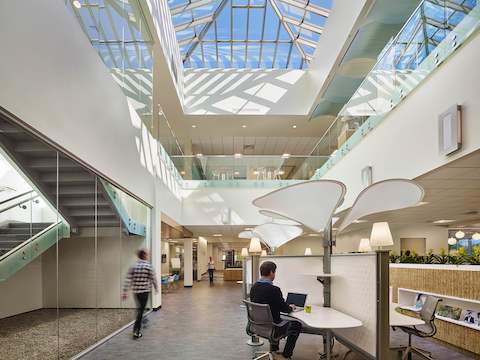
Living Office offers workers a variety of settings, allowing them to choose the one that works best for them. (Photos by Halkin | Mason Photography)
“Our associates know that they ultimately impact someone else’s work experience. That’s why we are here.”
—Tracey Wood, Global VP, People and Organization for Mars Drinks
A CLEAR PURPOSE FOR EVERY PLACE
Regardless of how clear the organization is about its purpose or even how strongly employees identify with it, sometimes a sense of purpose can be thwarted by the smallest things, e.g., not having enough horizontal space to spread out materials, trying to collaborate with team members while sitting next to a loud-talker, or even just needing to change things up in the middle of the afternoon.
Because work needs vary according to individual and group preferences, the task, or even the time of day, Living Office includes a variety of settings and allows associates to be intentional about the space and the work—to choose to work wherever and however they feel they can be most effective.
In a Living Office, each space has a purpose, and each space is optimized for that purpose, enabling people to do their part in accomplishing the company’s purpose. For associates who need to work with others, then alone, in quick succession, like on a project team, Mars Drinks provides them with a Hive to work in. When it’s time to write an annual plan, an associate can work undisturbed in a sheltered space called a Haven. With its central location, heavy foot traffic, and casual seating Mars Drinks’ Plaza is the heart of its Living Office—the place to check the pulse of the company and to catch a colleague.
At the same time that Mars Drinks was interested in purposeful settings, it was equally interested in purposeful movement between those settings. Instead of putting the people who regularly work together next to each other, the company separated them as a way of encouraging them to meet and talk to people with whom they don’t normally interact.
PURPOSE’S ULTIMATE PAYOFF
Associates say they appreciate the increased opportunities for connection that the new space affords, as well as the positive “buzz” of activity in the space, which keeps them motivated and engaged.
Engagement is exactly what Mars Drinks hoped its Living Office would help deliver. “The way we’re going to achieve our business goals is through talented, capable people who are passionate about the difference we can make in the workplace,” says Wood. Mars Drinks’ average length of stay is 10 years—not bad, considering that at 53 percent of companies, it’s under eight years.6
Says Brower, “This is an ultimate benefit of clear purpose—a culture and a workplace that attract employees and keep them engaged, focused, and contributing to the greater meaning of the organization through work that matters.”
Notes
1. David Ulrich and Wendy Ulrich. The Why of Work: How Great Leaders Build Abundant Organizations. New York: McGraw-Hill Education, 2010.
2. Drake Baer, “Jerry Seinfeld on the Perfection of the Coffee Meeting,” FastCompany.com, April 30, 2013, http://www.fastcompany.com/3008976/leadership-now/jerry-seinfeld-on-the-perfection-of-the-coffee-meeting
3. Tracy Brower. Bring Work to Life by Bringing Life to Work: A Guide for Leaders and Organizations, Bibliomotion, 2014, p. 169.
4. Dave Ulrich, personal email, January 21, 2015.
5. Herman Miller, “Living Office Culture,” May 2014, company confidential.
6. Jay Bilski, “How long do employees stay at one company?” CFO Daily News, January 26, 2011, http://www.cfodailynews.com/how-long-do-employees-stay-at-one-company/.


